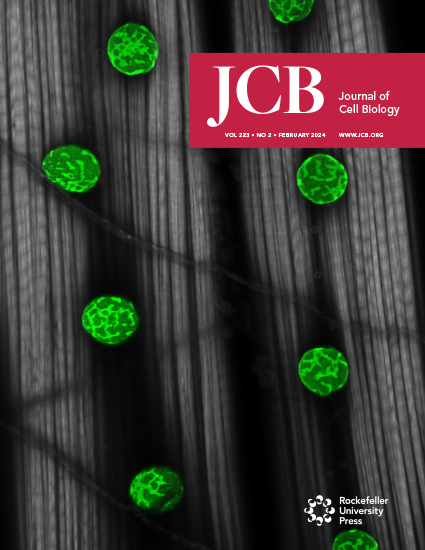通过ATAT1的B细胞机械转导协调免疫突触的肌动蛋白和溶酶体动力学。
IF 6.4
1区 生物学
Q1 CELL BIOLOGY
引用次数: 0
摘要
B细胞通过免疫突触的形成提取固定抗原,这一过程受抗原呈递表面物理性质的影响。然而,将机械转导与抗原提取和加工联系起来的机制仍然知之甚少。在这里,我们发现在硬底物上激活的B细胞启动机械转导反应,驱动微管乙酰化酶ATAT1从细胞核转移到细胞质,导致α-微管蛋白乙酰化增加。这种修饰在免疫突触释放GEF-H1,促进抗原提取所必需的肌动蛋白灶的形成。乙酰化的微管也使B细胞能够稳定和定位溶酶体在突触中心,从而将肌动蛋白依赖性提取与抗原加工和递呈结合起来。因此,atat1沉默的B细胞不能在突触界面聚集肌动蛋白病灶和溶酶体,导致抗原提取和递呈到T细胞受损。总的来说,这些发现强调了bcr依赖的机械转导如何诱导微管修饰,以协调免疫突触的溶酶体定位和肌动蛋白重塑。本文章由计算机程序翻译,如有差异,请以英文原文为准。
B cell mechanotransduction via ATAT1 coordinates actin and lysosomal dynamics at the immune synapse.
B cells extract immobilized antigens via immune synapse formation, a process influenced by the physical properties of the antigen-presenting surface. However, the mechanisms linking mechanotransduction to antigen extraction and processing remain poorly understood. Here, we show that B cells activated on stiff substrates initiate mechanotransduction responses that drive the translocation of the microtubule acetylase ATAT1 from the nucleus to the cytoplasm, leading to increased α-tubulin acetylation. This modification releases GEF-H1 at the immune synapse, where it promotes the formation of actin foci essential for antigen extraction. Acetylated microtubules also enable B cells to stabilize and position lysosomes at the synapse center, thereby coupling actin-dependent extraction to antigen processing and presentation. Accordingly, ATAT1-silenced B cells fail to concentrate actin foci and lysosomes at the synaptic interface, resulting in impaired antigen extraction and presentation to T cells. Overall, these findings underscore how BCR-dependent mechanotransduction induces microtubule modifications to orchestrate lysosome positioning and actin remodeling at the immune synapse.
求助全文
通过发布文献求助,成功后即可免费获取论文全文。
去求助
来源期刊

Journal of Cell Biology
生物-细胞生物学
CiteScore
12.60
自引率
2.60%
发文量
213
审稿时长
1 months
期刊介绍:
The Journal of Cell Biology (JCB) is a comprehensive journal dedicated to publishing original discoveries across all realms of cell biology. We invite papers presenting novel cellular or molecular advancements in various domains of basic cell biology, along with applied cell biology research in diverse systems such as immunology, neurobiology, metabolism, virology, developmental biology, and plant biology. We enthusiastically welcome submissions showcasing significant findings of interest to cell biologists, irrespective of the experimental approach.
 求助内容:
求助内容: 应助结果提醒方式:
应助结果提醒方式:


